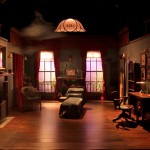Sherlock’s Last Case – Designer Simon Kenny’s Blog
17 October 2013
 With a building like The Watermill, with all its original features and the way it’s been converted – you have to work around it or work with it, there’s a bit of both in Sherlock’s Last Case. Some of the design features are built to work with it and at times we’ve tried to make the theatre disappear.
With a building like The Watermill, with all its original features and the way it’s been converted – you have to work around it or work with it, there’s a bit of both in Sherlock’s Last Case. Some of the design features are built to work with it and at times we’ve tried to make the theatre disappear.
I get my inspiration for design from everywhere; every show brings with it its own area of research. Obviously doing a play like Sherlock’s Last Case comes with a lot of material to reference. With all the books, the films, the museums, Sherlock Holmes is really well documented. Sometimes it becomes about the art or music of the period, or photography, and at other times the text takes on new meanings with time. Music is a really big influence, be it music of that period or not. When I’m designing costumes for modern shows or new writing, I often ask actors what music their character listens to, it won’t be referred to in the play, but it suddenly gives a really good sense of who they think they are and what kind of world they inhabit.
We also work with the wardrobe department and the actors. I find it very important to work with the actors in developing what the costumes should be. This is a slightly different play because they are such iconic looks. We know what Holmes and Watson should look like, and hints at character descriptions from the script reveal other features you need to be faithful to.
Sherlock is a fictional character, his Baker Street apartment doesn’t actually exist, but there are so many details in the books which tell you about the rooms, what’s on the walls, how it’s been decorated and how many steps from the front door into his apartment.
There are some brilliant people who have gone through all of these details in the books and then drawn maps and put together images of what they think these rooms would look like if all these details existed. We have, of course, had to adapt it slightly to accommodate for the audience who are looking in on these three dimensional rooms.
We did a lot of research at the Sherlock Holmes Museum, which has been constructed on Baker Street at the address that is closest to where 221B would have been. They’ve recreated the spaces with all the details from Sherlock’s stories. It’s brilliant being able to see what the proportions of the rooms would have been, what the buildings were like at that time, the way they would have been furnished and all the different details from the stories seen in one place. We’ve pulled various bits and pieces together from those worlds and then distilled it through The Watermill space to create the set.
There are so many people who know so much about Sherlock Holmes, who have ideas about what he should look like – mostly from the specific look in the 30s films. So we’ve referred to the stories, the locations, and even the films and the looks that have become iconic – we’ve wanted to reference those things as much as we can without being slavishly bound to recreate them.
Obviously Sherlock’s Last Case is a new story, but I think our interpretation of Holmes is familiar to people, whether they know the stories or not.
Simon Kenny
Designer
